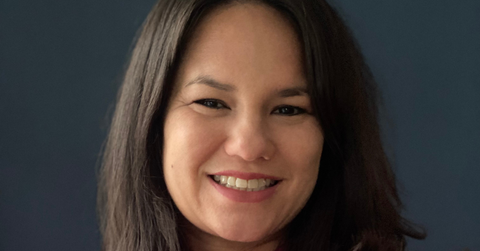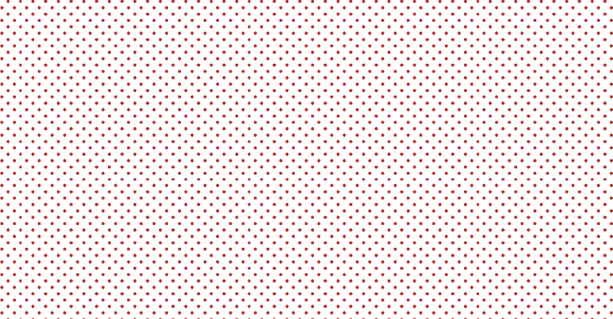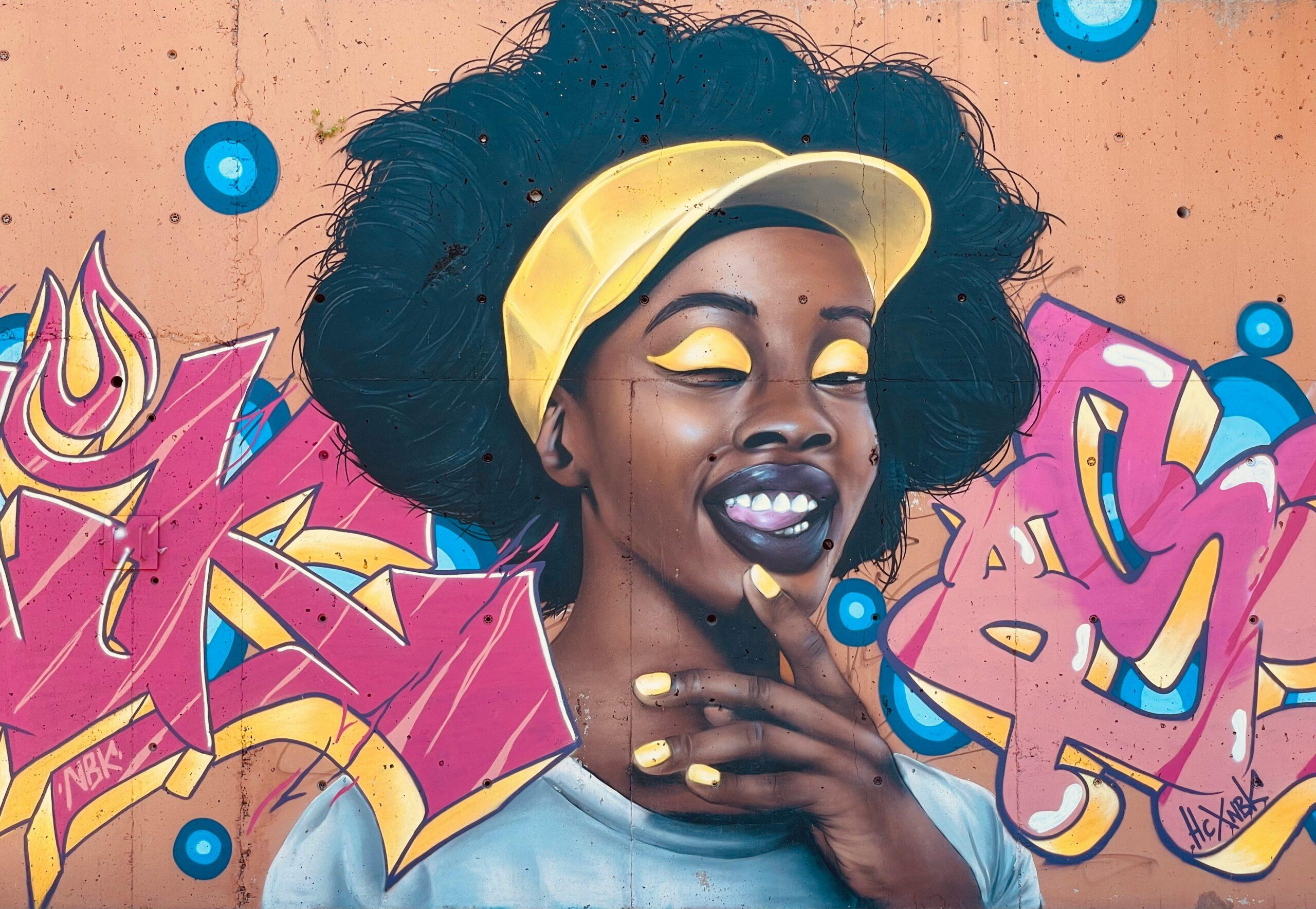How does someone go from being an apprentice graphic designer to the Vice President of Consumer Media at Springer Nature and President of Scientific American? Kimberly Lau attributes her non-traditional career path to a desire to be a decision-maker.
Kimberly’s decision to go to business school after five years in graphic design led her to what she calls her dream job: working in the digital division of Hearst Magazines. From there, she became head of digital strategy at The Atlantic, developing the organization’s digital brand. In 2022, she was hired by Springer Nature and Scientific American, where she wears two hats managing a legacy media brand and translating scientific research into information that can be easily digestible by everyday people.
We sat down with Kimberly to explore her experience and what advice she’d give to those who aspire to leadership roles.
Her Agenda: Tell me about your professional journey. What interested you about business, and specifically the business side of media?
Kimberly Lau: I have a non-traditional path. My love for media did start at a young age. I was really obsessed with magazines when I was a teenager, but never really thought about what a career would be.
I started out with an economics degree, but I graduated from college and decided that I really wanted to be a graphic designer, which I know sounds a little bit insane and I wouldn’t recommend that as a path to people. I worked for the first five and a half years of my career as a graphic designer. I realized in those five and a half years that I was a terrible designer and that wasn’t where my future was. I worked with some amazing artists who were amazing designers and were very skilled and I could see clearly that that wasn’t my strength. But I also could see that I had strengths in project management. I’d started getting into web design, which in the late 90s everybody was trying to figure out, and I was really enjoying that. Then, more importantly, I was working for a nonprofit and I couldn’t really see how the decisions of the company impacted the things that I was doing or being tasked with so I decided at that point that I wanted to be in the position to make those decisions, which led me to get my MBA.
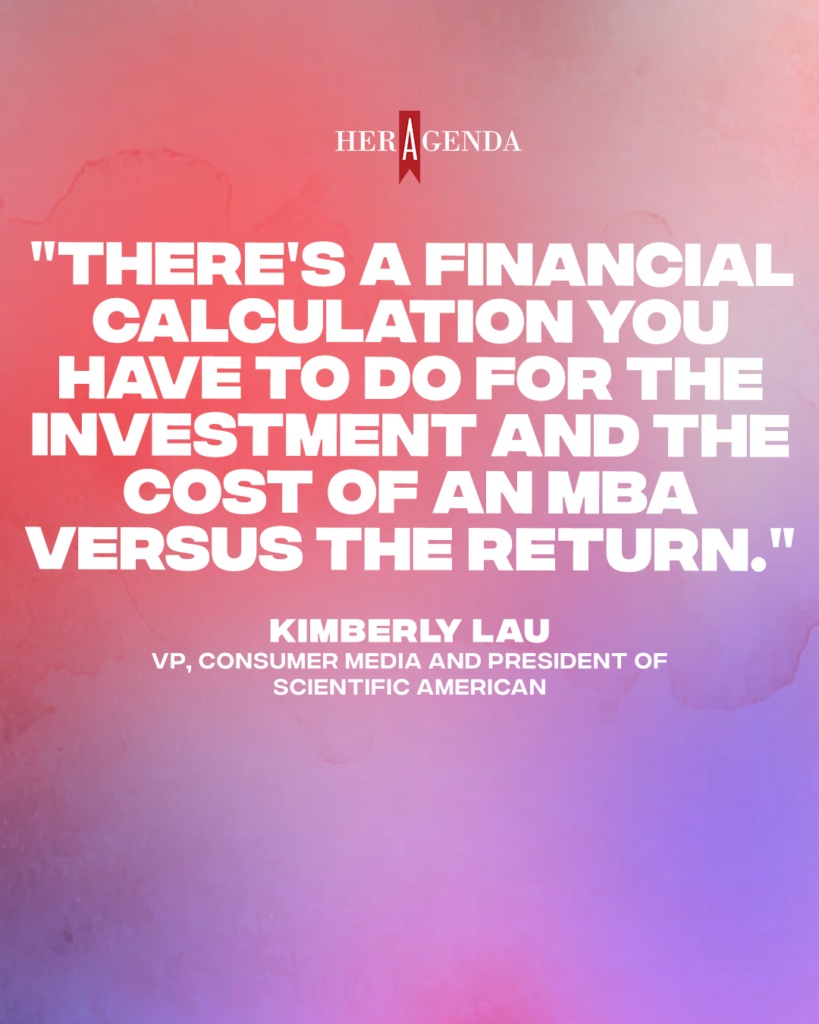
Getting your MBA is like a two-year job hunt. I pursued many paths over that period, but ultimately kept coming back to the question: What is my dream job? What I decided was I really wanted to work with creative people and I had a love for media. I was fortunate enough to land my dream job at Hearst Magazines in a new digital division that was tasked with trying to set up the strategy behind their websites and monetize those websites. I had the opportunity in my six years there to develop digital strategies to work on new media formats like video, to work closely with editors, and to structure partnerships. It was a really formative education on all things media and that sort of set me on my path.
From there, I went to The Atlantic, where I was in a slightly more operational role and they brought me in to head up digital strategy and partnership development. Essentially, I was in charge of everything that wasn’t editorial or sales and had a really great almost 10 years at The Atlantic. As a brand, we had some real successes over that time.
Then I was looking for my next gig and found Scientific American. I’m now VP of Consumer Media for Springer Nature and President for Scientific American, which means I essentially have two businesses. I have Scientific American in the US and then its sister brand Spectrum in Germany. We’re about 18 months in and it’s been a good ride so far.
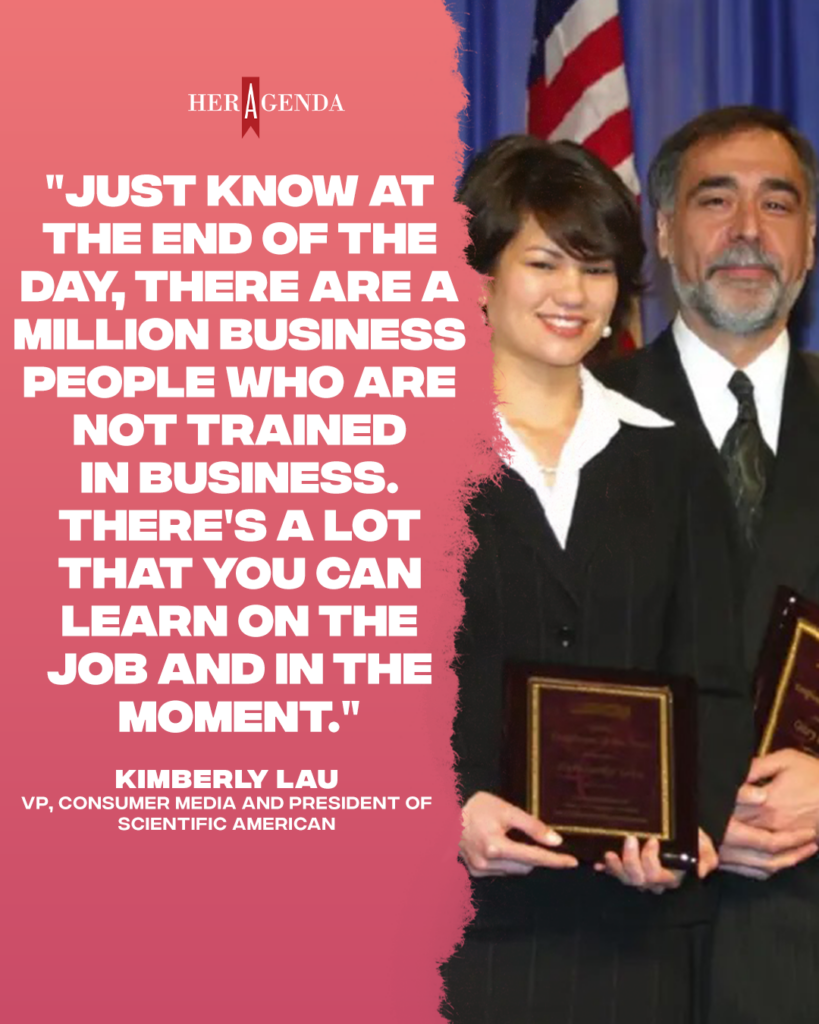
Her Agenda: How do you define “consumer media?” What does it mean for your new role and what does it look like for Springer Nature and Scientific American?
Kimberly Lau: Springer Nature is one of the largest research publishers in the world and what that means is that at the core of their business is publishing research papers in journals and all the aspects associated with that. It is not ultimately a business that’s focused broadly on the masses. So our two brands are really the only brands that are focused on trying to take and translate science for a general population. So “consumer” really just means that Scientific American’s audience is a slightly wider audience than the rest of Springer Nature’s focus. The primary way that these two brands have made money in the last 20 years has been really from subscriptions being sold to individuals. Functionally what it means is that as a business within the larger company, the way that we think about our business, the way that we operate, and the things that we need to do are just slightly different than the rest of the business. There are some overlaps and with digital there are more similarities in the future than there have been necessarily in the past. But it does mean we’re kind of like a unicorn within Springer Nature. We’re a little different than the rest. We’re essentially focused on cultivating broad consumer audiences, and then monetizing through subscriptions as well as advertising partnerships.
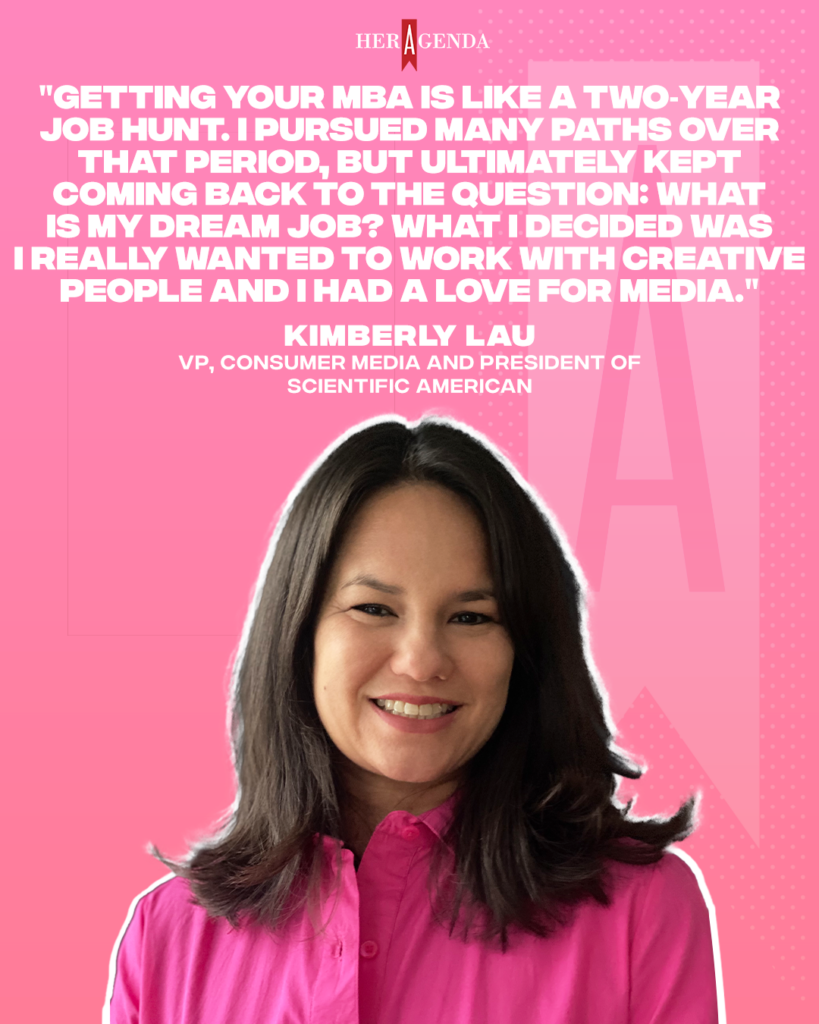
Her Agenda: Now that you are a decision-maker, what is your vision for the future of Springer Nature and Scientific American?
Kimberly Lau: Scientific American is the oldest magazine in the United States [that is still in production today]. It’s 178 years old and has historically been a magazine. What’s really exciting about where we’re at, and what we’re doing, is that the future of media is less about a specific format. So it’s not about us being a magazine, it’s about us being a multi-platform brand. That sounds simple and maybe easy to do, but it requires very different skill sets. In some ways, it requires us to be expansive in how we think about the brand and how the brand evolves over time. We’re at another pretty critical pivot where a lot of what we’re thinking about today is: How do we cultivate and inspire and develop the next generation of science enthusiasts?
It just so happens that we’re at a point in time in the world where the need for science-based information, in many ways, has never been greater. Part of what we’re trying to do as we reimagine and expand Scientific American is to think about that next generation. We’re launching a redesign of our brand, which [partially] manifests itself in the logo. We will have a redesigned print magazine, but you’ll also see this new logo across all of our social media sites. We’re also launching on TikTok later this month, which we are a little scared about but also very excited about. It’s definitely a platform that I have a lot to learn about. Fortunately, we’ve got some people on the team who are very knowledgeable and I’m confident are going to produce some great stuff.
What’s exciting going forward is figuring out how to push the brand to expand, [while also] staying true to what we’ve always wanted to do, which is share the most interesting science stories, educate, and inspire people. But how do we do that in ways that we haven’t in the past? We’ll continue to do feature articles, but it will come through in our podcasts, it will come through in our video content on TikTok, everywhere else, and whatever comes next.
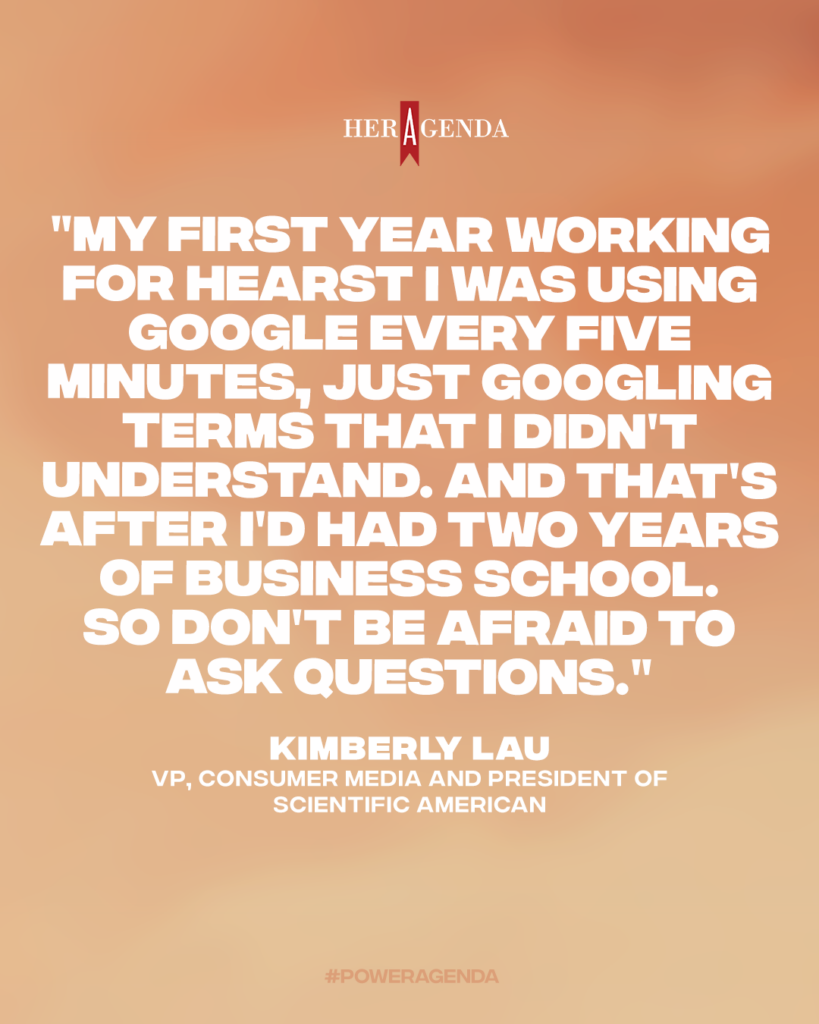
Her Agenda: What are some challenges facing digital media brands in our current climate?
Kimberly Lau: One of the big challenges is just the speed of change. When you’ve been doing one thing for a really long time, you’re not necessarily used to having to change and reinvent yourself and think about how you take advantage of new platforms on a daily or yearly basis. This year in digital we’re seeing traditional distribution channels mature and actually change pretty dramatically. In the last 10 years, Facebook has been a big source for most news outlets’ traffic, and that is changing what feels like overnight. If you watch the dumpster fire that is Twitter, or X, for the past 10 years, those platforms have been critical pieces of most digital media strategies and they’re literally remaking themselves overnight. Not only do we not have control of those distribution points, but we have to keep up and we have to figure out what’s next. That requires that we as a team have the agility and the capacity to do that, which is something that for most brands going from legacy formats to digital was quite difficult. The team is doing great, but it’s definitely one of the big changes that require thinking out of the box: How does Scientific American represent itself in a short video format versus an audio format versus print? The speed of change is a big challenge. There are other things like the ongoing decline of newsstands and print that continue to be challenges for anybody who’s made money and continues to make money in those places. But that’s not necessarily surprising, just part of the ongoing management of trying to maximize where our opportunities are.
Her Agenda: What challenges have you faced as a woman in the business industry?
Kimberly Lau: When I was starting out, I really didn’t have a vision. I went to business school in 2004 and my class at [UVA Darden School of Business] was 20% women. It was, quite honestly, the first time in my six years of working that I’d ever felt that I was at a disadvantage. I had a wonderful time at Darden, it was lovely. But you start to feel it when only one out of five people is a woman. In some ways that prepared me for when I went to Hearst, and I had meetings on the executive floors. By and large, the only women on the executive floors are admins. I don’t know if you’re ever comfortable in those situations, but it prepares you.
I was really fortunate because I had a lot of wonderful mentors. With the exception of one, I’ve only had male bosses and I’ve never had a bad one, to be honest. There were different strengths across the board, but I’ve had a lot of good mentors and bosses.
The biggest challenge when I look back on it now was actually when I had my first daughter. I was in a position where I traveled a fair amount with men and some of them had kids, some of them didn’t, but they all had partners at home that had more flexibility or were the primary parents. I spent a lot of time pretending like I didn’t have kids, which is not necessarily what I would recommend people do today. I think things have actually changed a lot for the better, but the only way that I made it work was by having full-time care. We had a full-time nanny, which we were fortunate to be able to afford, and I also had a husband who was as invested in my career as I was and, even though he had his own career, was willing to be 100% a partner.
The one piece of advice I would give people is when you’re thinking about your partner and thinking about where you want to be it’s important that you share those interests and those goals because without a doubt my husband has been a critical part of ensuring that I can take every opportunity, and I can tackle them almost like I didn’t have kids. [He and I] being on the same page with that was really critical.
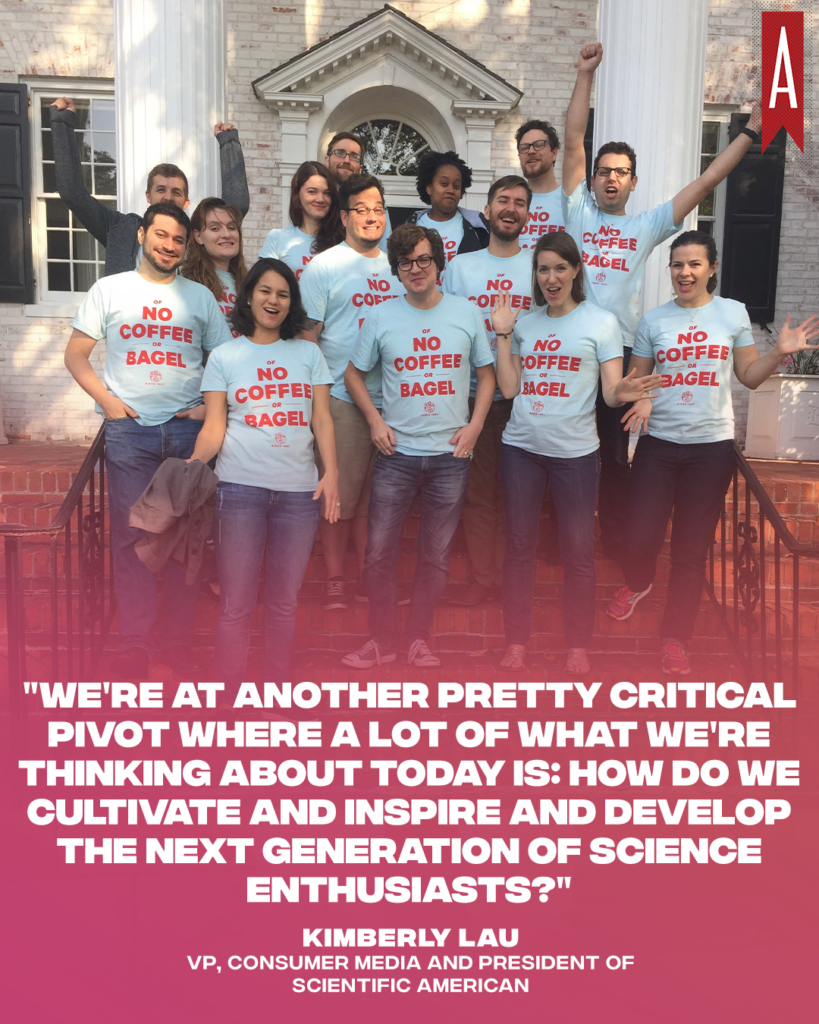
Her Agenda: You mentioned the positive impacts mentors have had on your career. What were some of the most impactful mentorships you had?
Kimberly Lau: My first boss at Hearst Magazines, was a man and he had been in the business for years. He was amazing because he took me under his wing. He knew so much about the industry, and about the company and was willing to sit down with me before every meeting and talk to me about what we were trying to accomplish. I didn’t really understand this at the time, but what he was really doing was walking me through his own thinking process so that I could take that and be able to understand why we had the conversations we had and what we were seeking to get out of it. One of the things Hearst has always done really well and that he sort of embodied for them was in thinking about strategic partnerships and how you partner with other companies. To this day that is part of my ethos and how I think about who we work with, why we work with them, and how we make them a successful part of our story. We have a partnership now at Scientific American and Springer Nature with one of our commercial partners, Takeda Pharmaceuticals, and one of the reasons it’s so successful is that it’s really a multi-year, multifaceted partnership where we spend a lot of time together. We understand across many levels what’s important to each side where our strengths are, taking the time to build those kinds of relationships really pays off.

Her Agenda: What advice would you give to someone who aspires to a leadership role or who is interested in business?
Kimberly Lau: An MBA can be super useful, but it depends on the person and where you are in your career. It made tons of sense for me. There’s a financial calculation you have to do for the investment and the cost of an MBA versus the return.
The thing that I would just remind people is that by and large, it’s not rocket science. Budgets are just trying to figure out what your costs are going to be and how much you’re going to get back on that. Strategy is really just another word for making a plan. So my encouragement would be: number one, don’t be intimidated. Number two, don’t be afraid to ask about what you don’t understand. It’s also true that in every industry we can get into the habit of using acronyms or shortcuts to things and forget that people don’t know them. My first year working for Hearst I was using Google every five minutes, just Googling terms that I didn’t understand. And that’s after I’d had two years of business school. So don’t be afraid to ask questions. Don’t be afraid to Google. Just know at the end of the day, there are a million business people who are not trained in business. There’s a lot that you can learn on the job and in the moment. If people are interested in that, I would encourage them to take on leadership opportunities, be curious, and ask lots of questions. It will come in time.

